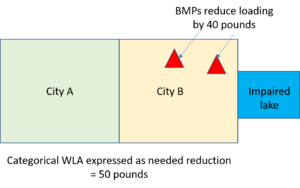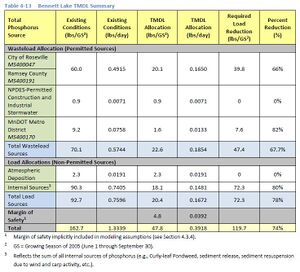
Guidance for categorical TMDLs
Many total maximum daily loads (TMDLs) lump multiple wasteload allocations (WLA) into a single WLA. This single WLA is called a categorical WLA. This page provides guidance to MS4 permittees for interpreting categorical WLAs.
Contents
Advantages and disadvantages of categorical WLAs in TMDLs
The primary advantage of a categorical WLA is that it provides a single value that all permitted MS4s can work toward achieving. This provides greater opportunity to implement pollution reduction practices efficiently. Examples include the following.
- BMPs can be implemented in locations that are most cost efficient and most effective
- Cooperative implementation of BMPs is encouraged
- A single entity, such as a watershed district, can act as an aggregator of pollution reductions
Categorical WLAs have disadvantages.
- Responsibilities for individual permittees are unclear
- Permittees that have been aggressive in stormwater management are lumped with permittees who have done limited stormwater management
Addressing categorical WLAs
It is not necessary or required to derive an individual waste load allocation (WLA) for a total maximum daily load (TMDL) that developed a categorical MS4 (Municipal Separate Storm Sewer System) wasteload allocation (WLA). Permittees can work together to cumulatively meet required pollutant loads or pollutant load reductions. If a permittee chooses to derive its own pollutant target, there are several options. This section provides guidance for cumulatively meeting a categorical WLA or deriving an individual target.
Cumulatively meeting a categorical WLA
Permittees can work together to meet a categorical WLA. This is a favored approach if the following conditions exist.
- There is an entity that can act as an aggregator. An aggregator tracks implemented activities and associated pollutant reductions or pollutant loads. Watershed districts often can function as an aggregator.
- Funding options for BMP implementation are flexible and can be applied toward selecting the most effective practices and locations for implementation. Because permittees can take credit for activities implemented within the watershed of concern by different entities (e.g. different permittees) when meeting a categorical WLA, funds can be focused on projects that achieve the greatest benefit at the lowest cost. Watershed districts are one mechanism for funding projects that are most cost effective. Grants and low interest loans are other examples of funding that can be gained when permittees work together to implement the most cost effective BMPs. Trading between permittees may be another option.
In the adjacent image, two cities work cooperatively to implement two BMPs close to the impaired water, where they are most effective. Both cities can apply the reductions toward their permit requirements provided the permittees mutually agree to do this.
Determining a target load
If a permittee is part of a categorical WLA but wants an individual target load, there are several methods to calculate the target load. Note that target loads are not approved WLAs. Permittees should consult the MPCA when developing target loads. The MPCA has geographic information systems (GIS) TMDL project area shape files that could be useful in estimating an MS4's portion of the categorical WLA. Contact the MS4 stormwater program for assistance or to request this information. The following approaches can be used to estimate your MS4's WLA.
- Area approach. The area approach is the simplest approach. The WLA can be divided based on the area of each MS4. Only areas within the TMDL impaired watershed should be considered. For example, if two MS4s have a WLA of 100 lbs/day, MS4 A covers 75% of the study area and MS4 B covers 25% of the study area, the target loads would be 75 lbs/day for MS4 A and 25 lbs/day for MS4 B. This is a desirable approach if the pollutant loading per unit area is considered similar across all MS4s. The TMDL report may contain information that is useful if your MS4 is going to use this approach. For example, the Ramsey Washington Metro Watershed District Watershed TMDL report (2017) contains the following table. This information, along with the TMDL table can be used to derive an individual WLA. MS4 Summary for Bennett Lake
- Population approach. The WLAs can be divided based on the relative population of each MS4. Only the population living within the study watershed should be considered. This approach is similar to the area approach and may be more desirable if population densities are considered homogenous across all MS4 areas. This approach could be used if the categorical WLA only includes city and township MS4s. This approach should not be used if the categorical WLA contains multiple types of MS4s since some MS4s do not have a population associated with them (e.g. counties, colleges/universities, Minnesota Department of Transporation (MnDOT)).
- Land use approach. The WLAs can be apportioned based on land use if the loading from the MS4s differs significantly. For example, assume two MS4s have a categorical WLA of 100 lbs/day. MS4 A has an area of 60 acres that includes 60 acres of commercial land use. MS4 B has an area of 40 acres that consists of residential land use. Assume commercial has a loading factor of 2, and residential 3. Multiplying the loading factors by acres gives a value of 120 for MS4 A and 120 for MS4 B. Thus, in terms of relative loading the two MS4s are equal even though MS4 A covers more area. The target loads for eash MS4 would be 50 lbs/day. The MPCA Simple Estimator could be used to determine the existing loading.
- Model approach. A MS4 can replicate the model used for the TMDL to determine its current pollutant load. This can be compared to the estimate of current load for all MS4s. The fraction contribution from the MS4 to overall loading is multiplied by the overall MS4 WLA to derive the individual target loads for the MS4.
Link to this table
| Waterbody | MS4 Name | MS4 ID Number | MS4 Area within the contributing watershed (acres) |
|---|---|---|---|
| Bennett Lake | City of Roseville | MS400047 | 632 |
| Ramsey County | MS400191 | 45 | |
| MnDOT Metro District | MS400170 | 55 |
The adjacent image shows that the total WLA minus the WLA for construction and industrial stormwater is 21.7 lbs/yr. According to the table above, Roseville is 86% of the total MS4 area and Ramsey County is 6%, Roseville could assume their MS4 is 86% of the total WLA, so their individual allocation would be estimated to be 18.7 lbs/yr and Ramsey County's estimated WLA would be 1.3 lbs/yr. MnDOT already has an individual allocation of 1.6 lbs/yr.
If this information is not readily available, MPCA Stormwater staff can assist your MS4 in determining the areas for each MS4 in the watershed area of the TMDL.

